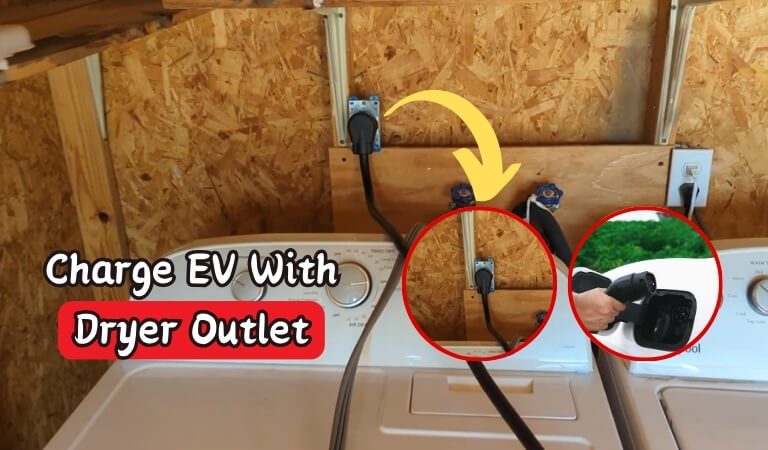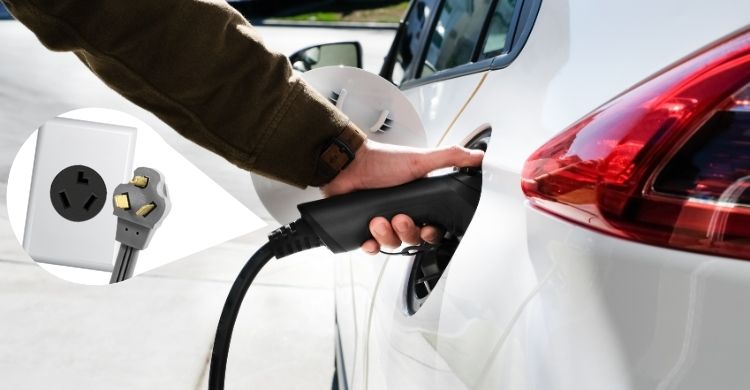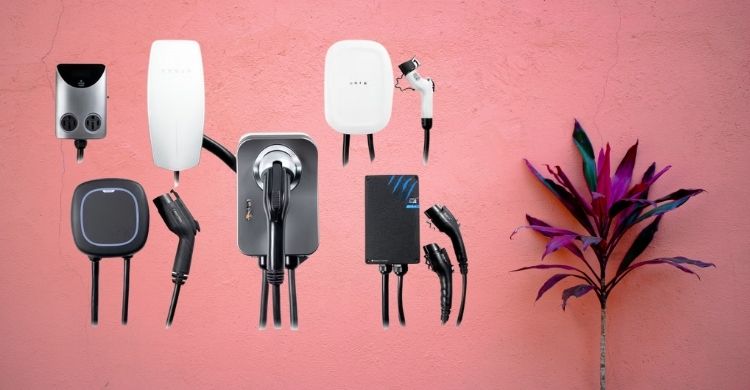Charging an electric vehicle at home saves time and money for many drivers. Some people wonder if their dryer outlet can power their EV safely. The good news is that you might not need expensive upgrades right away. A simple adapter could make your existing outlet work with your car. Henceforth, a question that comes to mind “Can I use my dryer outlet to charge my EV?”
Yes, if the outlet provides 240 volts and fits your charger’s plug. You may need an adapter or a Level 2 charger with the right NEMA plug. Always check the outlet’s power limits and follow safety rules in your area.
Want to know how to set this up without risks? Keep reading for the full guide!
Can I Use My Dryer Outlet to Charge My EV?
Using your dryer outlet to charge an EV might seem easy. It’s already there, powerful, and looks like a match. But it’s not always that simple.
Yes, it’s true that you can use your dryer outlet to charge your EV, but there are important things to check first. It’s not plug-and-play in every case, and mistakes can be risky. Safety, code, and compatibility all play big roles here.

Plug Type and Outlet Match
Dryer outlets often use NEMA 14-30 or 10-30 plugs, while many EV chargers need NEMA 14-50. Using the wrong plug might damage your equipment. Matching plug types is necessary, and wrong connections may cause fire or short circuits quickly.
Different homes come with different outlet shapes, depending on their age and setup. You might need an adapter for your EV charger to fit. But some adapters are unsafe, and poor-quality ones can overheat and cause trouble.
Circuit Breaker Load Limit
Dryer outlets usually connect to 30-amp breakers, but most Level 2 EV chargers pull more amps than that safely allows. Charging with a high amperage here risks tripping your breaker. It may stop charging or cause wiring heat buildup.
Even if your charger runs at lower amps, the long-term load stresses the circuit. Dryers only run for short times; EVs may charge for hours. That extended use is harder on wiring and breakers, risking overheating problems.
Shared Circuit Problem
Dryers and EVs should never share the same outlet without switching hardware. Plugging in both may confuse the circuit and cause big trouble. You can’t run both devices safely on one connection.
Circuits not made for full-time use can’t handle long EV charging sessions. If both are plugged in, it might draw too much power. Fires, breaker trips, and damage to appliances may happen fast.
Code Compliance and Local Rules
Electrical codes change from place to place, and not all allow EV charging on dryer circuits. Some areas need special outlets just for EVs. It’s smart to ask an electrician who knows local rules.
Failing to follow the code may void insurance or cause issues during home sales. An inspector might flag the outlet as unsafe for EV charging. Homeowners could be asked to remove it or fix the setup later.
Cable Length and Location
Your EV needs to reach the outlet with a charger cord, which might not always be long enough. If the car port’s far, charging won’t work well. Moving cords around could damage them or pose tripping risks.
Outlets for dryers are often in tight spots or in basements. Running cords through doors or windows creates safety concerns. Rain, pets, or people could get hurt or damage something.
Charging Speed Limits
Charging through a dryer outlet is slower than using a proper 240V Level 2 charger. Your car may need more time to fully charge. That can delay daily drives or plans.
It might take 8-10 hours for a full charge with this method. For many people, that’s fine overnight. But longer wait times may be frustrating during busy weeks or road trips.
Safety and Fire Hazards
Worn-out outlets or loose plugs can spark or burn when used for EV charging. That kind of wear isn’t always easy to spot. Over time, the heat builds up and causes bigger risks.
If a plug feels hot after charging, that’s a warning sign. Frequent overheating damages both the charger and the wall outlet. Always check cords, plugs, and outlets for black marks or strange smells.
Adapter Quality and Charger Type
Some chargers support dryer outlet use with built-in settings, but others need an adapter. Cheap adapters may not meet safety standards. Even branded ones should match your charger’s voltage and amperage needs.
High-quality EVSEs (Electric Vehicle Supply Equipment) allow safe dryer outlet use with no setup changes. Check for UL or safety certifications before using adapters. Ask the EV charger company for advice before buying gear.
The Factors You Should Consider Before Charging Your EV at Home
Charging your EV at home sounds simple, but it needs smart thinking. You must plan for safety, cost, and the right setup. Many drivers skip key steps, and that can cause trouble fast. Take time to check these points before plugging in your vehicle.
- Home wiring needs to match the charger’s power, or it may overheat. Wrong wires lead to melted insulation and sudden fire risks.
- Circuit breakers must support the charging load for long hours. Dryers use short bursts, but EVs charge for much longer stretches.
- Outlet types matter for safety and charging speed. Using mismatched plugs can burn connectors and damage expensive charger units.
- Charger cable length must reach your car without tension. Stretching cords across spaces creates tripping hazards and may wear cables.
- Local codes may block EV charging on shared circuits. Some areas require separate lines and permits before setup begins properly.
- EVSE units must support voltage needs and plug type. Some models need adapters while others work better with built-in settings.
- Charging location should stay dry, well-lit, and secure. Wet or cluttered spots lead to slips, shocks, or accidental wire cuts.
- Adapter quality affects power stability and safety checks. Low-grade tools overheat quickly, risking both fire and charger shutdowns.
- Energy cost rises if charging daily without off-peak plans. Nighttime rates are cheaper, and smart timers can help reduce bills.
- Your car’s battery size decides charging hours and electricity draw. Bigger batteries mean longer charge times and higher load needs.
If you’re in need of help setting up, always consult professionals trained in EV wiring. A trusted EV charging service provider in Bangladesh can guide you with correct gear, rules, and local permits. Choosing the right expert early saves time and avoids costly errors later on.
How to Charge Your EV Using a Dryer Outlet: Step-by-Step
Charging your EV using a dryer outlet can save time and cost if done properly. Many people already have this outlet installed at home. Follow these steps to ensure safe, reliable charging without damage or fire hazards.

Step 1: Identify Your Dryer Outlet Type
Start by checking the plug shape and prong count on your dryer outlet. Most homes use either a NEMA 14-30 or 10-30 type. Match this with your EV charger plug to avoid mistakes. If they don’t match, you may need a safe, approved adapter.
Step 2: Check the Circuit Breaker Rating
Dryer outlets typically use a 30-amp breaker, while some EV chargers require more. Make sure your charger’s current draw doesn’t exceed the circuit rating. If it does, it may cause heat buildup or breaker trips. For safety, use chargers that support adjustable current settings.
Step 3: Get the Right EVSE or Adapter
Select an EVSE (Electric Vehicle Supply Equipment) that works with your outlet type and amperage. Some chargers come with interchangeable plugs or built-in safety features. If you use an adapter, make sure it’s certified and fits tightly. Avoid cheap, untested adapters that can overheat easily.
Step 4: Position Your Car and Charger Safely
Park your EV close enough to the outlet so the charger cord lies flat on the ground. Avoid running cables across doorways or through windows. Sharp bends or stretched cords can wear the insulation quickly. Keep children and pets away from the charging area.
Step 5: Test the Setup Before Full Use
Before a long charging session, plug in and monitor for 10–15 minutes. Check the charger and outlet for heat, noise, or odor signs. If anything feels odd, stop charging and inspect all parts. This step helps prevent issues from poor connections or overloads.
Step 6: Monitor Charging Time and Speed
EVs usually take 6 to 10 hours to charge in a dryer outlet, depending on battery size. Watch how fast the battery fills up during the first few tries. Use your car’s app or screen to track charging progress. Make sure the charging doesn’t continue past the battery limit.
Step 7: Unplug and Store Equipment Properly
Once your EV is fully charged, turn off the charger before unplugging. Coil the cable neatly to prevent wear or kinks in the wire. Store adapters and plugs in a dry place, away from heat or sharp tools. Keeping your setup clean helps extend its life.
Potential Risks and Limitations You Should Know
Charging your EV at home is easy, but not without risks. Many drivers overlook key details that could cause trouble. Even one small mistake can harm your car, outlet, or charger. Knowing these limits can help you stay safe and avoid extra costs.
- Loose or old outlets may spark while charging, causing smoke. Heat from bad plugs leads to melted wiring and hidden fire dangers.
- Some adapters lack safety approval and may overheat. Cheap parts melt fast and can’t handle continuous power flow without issues.
- Long charging times strain circuits not built for heavy use. Wires heat up inside walls, even if nothing looks wrong outside.
- Charging cords stretched across rooms create tripping risks. People or pets might pull them loose, break plugs, or damage cables.
- Wet or damp charging areas can shock users or short the circuit. Never run cables through windows or near water sources.
- Car software might not match certain chargers or plugs. Glitches may stop charging or cause random errors during connection.
- Circuit breakers may trip from overload or stay hot for hours. Breakers that reset often are warning signs of serious problems.
- Using one outlet for both the dryer and EV is unsafe. That extra load causes flickering lights, weak charging, or full shutdowns.
- Many people don’t know the difference between a level 1 and level 2 EV charger, which leads to a wrong setup or poor charging results.
- Old homes may lack updated wiring or proper grounding. Connecting modern EV chargers to outdated panels often risks major electrical failure.
When to Consider a Dedicated EV Charger Instead?
Charging an electric vehicle at home feels simple at first. Many start with shared outlets but run into problems later on. Here’s when you should consider switching to a dedicated EV charger for better performance and safety.

Daily Charging Becomes a Routine Need
You might drive often and need quick charging every night to stay on schedule. A slow outlet can’t keep up consistently. Charging overnight should be reliable, not hit-or-miss depending on usage. Dedicated EV chargers offer faster, more stable results for regular driving patterns.
Tripping Breakers or Outlet Overheating
When your breaker trips during charging, it’s a clear sign the outlet can’t handle the load. You may feel heat near the outlet. These are warning signs that shouldn’t be ignored under any condition. A dedicated setup reduces stress on your home’s electrical system.
Upgraded EV or Larger Battery Installed
Newer EVs often have bigger batteries that need longer charging times. Standard outlets charge them too slowly to be useful. Dedicated chargers work better with high-capacity batteries found in newer models. Your EV should charge fully without delay or interruption every time.
Outlet Location Doesn’t Suit Your Setup
Sometimes the existing outlet is too far from your car’s usual parking spot. Stretching cables across paths can be dangerous. Tripping hazards and poor cord placement create issues every day. A dedicated EV charger lets you install it where it’s actually needed.
Better Performance and Smarter Features Required
Many dedicated chargers offer Wi-Fi control, timers, and energy tracking tools. These help you monitor and schedule your charging more easily. If you’re trying to lower costs or track usage, these features are helpful. You won’t find them in basic shared outlet setups.
Expert Tips for Charging Your EV Safely at Home
You can charge your EV at home, but safety must always take priority. A small mistake can lead to big damage quickly. By following expert-backed habits, you can protect your vehicle, your home, and your peace of mind. Use these tips for stress-free and smart charging:
- Hire a certified electrician to inspect your home’s wiring before installation. Skipping this step may cause hidden problems during long charging hours.
- Always use a charger with UL or certified safety approval. Cheap or untested devices can overheat, spark, or cause fire risks.
- Keep the charging cable away from wet surfaces and sharp tools. Water or sharp edges may damage insulation and expose live wires.
- Don’t let cords stretch across walking paths or under doors. Foot traffic and pinching can ruin plugs or cause tripping injuries.
- Set charging to begin during off-peak hours using your EV’s app. This helps lower electric bills and avoid grid overloads nightly.
- Touch the plug and outlet after 15 minutes to check for warmth. Any heat means something’s wrong and should be fixed soon.
- Wall-mounted chargers stay cleaner and safer than floor models. They also reduce cord wear from tangling, bending, or poor storage.
- Label your breaker clearly if the circuit powers your EV charger. Quick access during emergencies can help avoid costly damage.
- Many experts suggest you unplug EV charger when not in use to avoid phantom loads or unexpected short circuits inside the wiring.
- Clean the charging port gently with a soft cloth once a week. Dirt or moisture inside may interfere with steady connections.
Frequently Asked Questions About EV Charging With Dryer Outlet
Using a dryer outlet to charge your EV is possible, but it depends on several conditions. While it might seem like a convenient shortcut, it’s important to understand the limits and safety factors. Here are 8 lesser-known but relevant questions you might have.
Can Using a Dryer Outlet Void My EV Warranty?
Using an unapproved charging setup, including certain dryer outlets, may void parts of your EV warranty. Always check your manufacturer’s guide. They often list approved charger types and usage instructions. Ignoring those guidelines could affect future service or repair claims.
Is It Safe to Charge Overnight Using a Dryer Outlet?
It’s usually fine if the circuit is in good condition and meets power demands. However, older wiring or loose connections raise risks. Overnight charging means long power flow, so heat buildup can occur. Always inspect the outlet regularly before extended use.
Do All EV Chargers Support Dryer Outlet Use?
Not all chargers are built for dryer outlet use. Some require higher voltage or different plug types. Always check the charger’s input options and manuals. Using an incompatible setup can damage both the charger and your home’s electrical system.
Will a Dryer Outlet Work for Dual EV Charging?
Dryer outlets aren’t strong enough to charge two EVs at the same time. Their amperage is limited and may trip the breaker. If you need dual charging, a proper Level 2 setup is safer. Avoid splitting the load without expert advice.
Does Using an Extension Cord With a Dryer Outlet Work?
Using an extension cord with a dryer outlet is not recommended. These cords can’t always handle the full current safely. Overheating and electrical fires are common with long or weak cords. Always plug the EVSE directly into the wall outlet.
Can I Install a Switch to Alternate Between the Dryer and the EV?
Yes, a manual transfer switch can be installed by an electrician. It allows you to toggle safely between dryer and EV. This avoids unplugging each time and reduces wear on plugs. Always use switches rated for your outlet’s voltage and amps.
How Do I Know If My Outlet Needs Replacement?
Look for discoloration, loose prongs, or strange smells near the outlet. These signs mean damage or heat stress. If plugs don’t fit tightly, the outlet may be worn. Replace it before using it for EV charging to avoid hazards.
Is There a Way to Boost Charging Speed Using That Outlet?
Dryer outlets are limited by their breaker and wire size. You can’t increase speed unless the circuit is upgraded. Lower your EV charger’s amperage to avoid overloading it. Faster charging requires a dedicated, higher-capacity Level 2 charging station.
Last Words
A dryer outlet can be used to charge your EV at home, but only if it is done carefully and correctly. While it saves time and avoids the cost of a new installation, it comes with real limitations.
Before asking, “Can I use my dryer outlet to charge my EV?”—make sure your outlet matches the plug, your breaker can handle the load, and local codes allow it. Always check the wiring condition, outlet location, and adapter quality before starting. Safety should never be an afterthought. When in doubt, talk to an expert. A little planning now can prevent big problems later.
